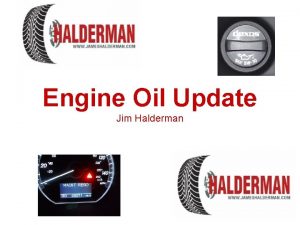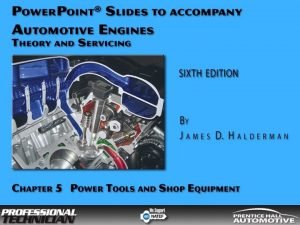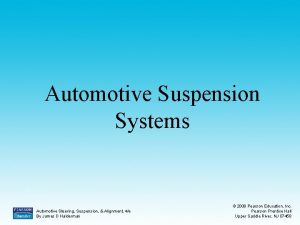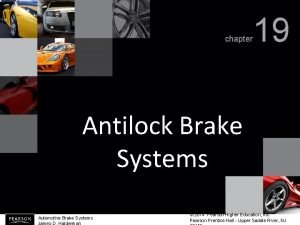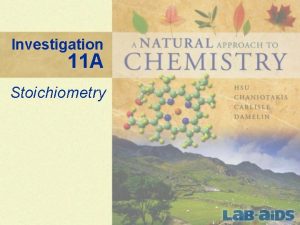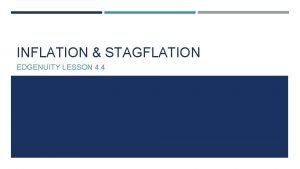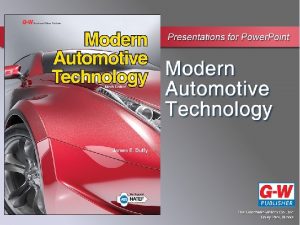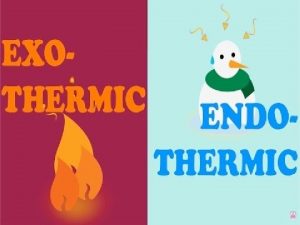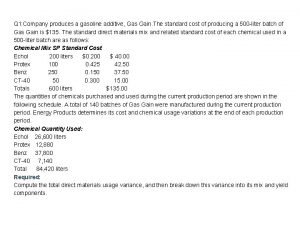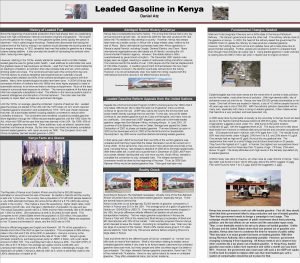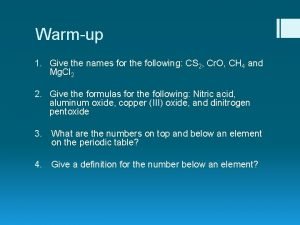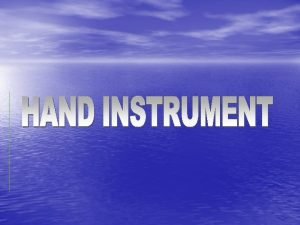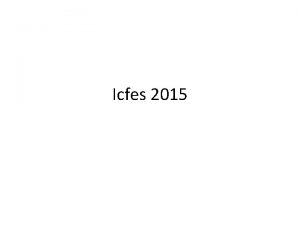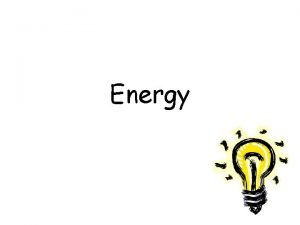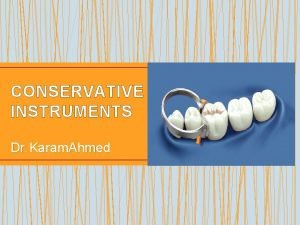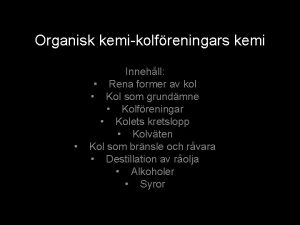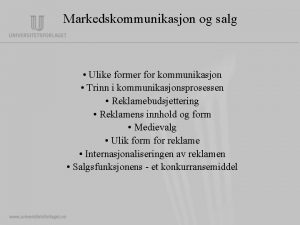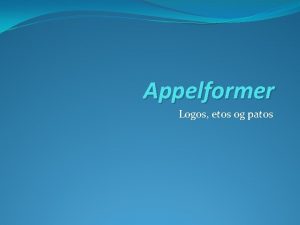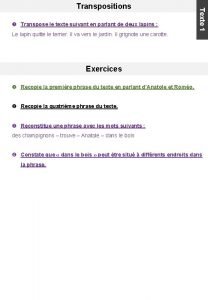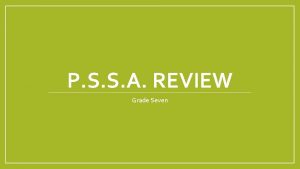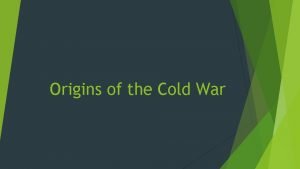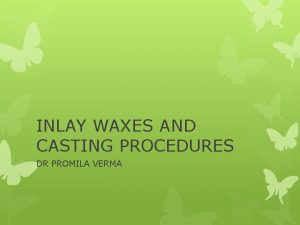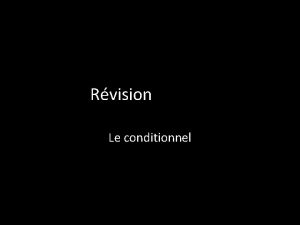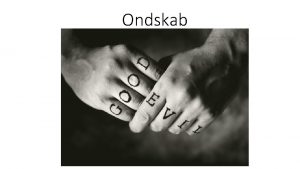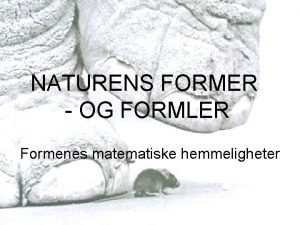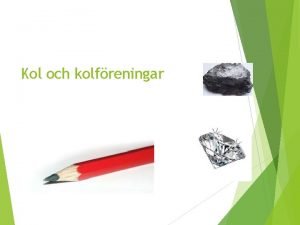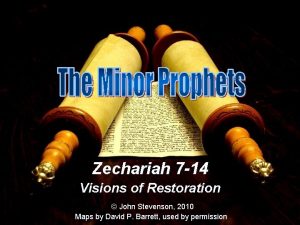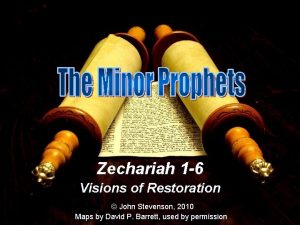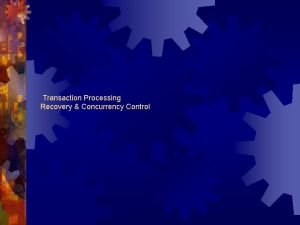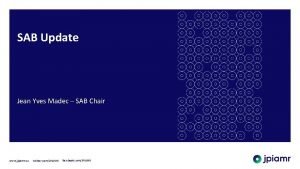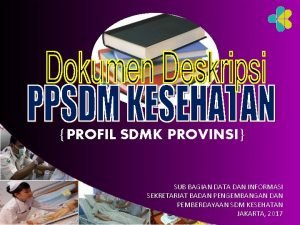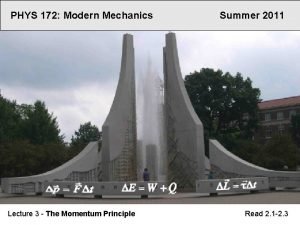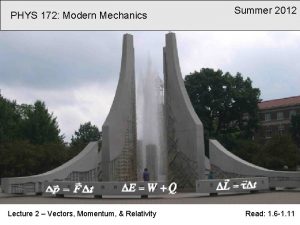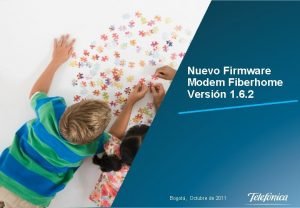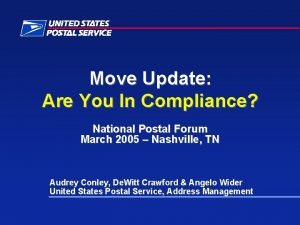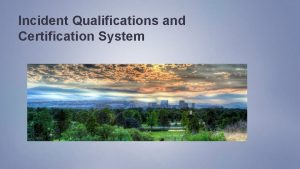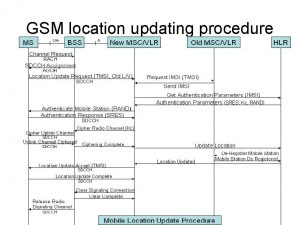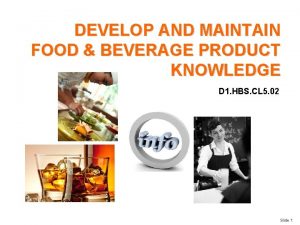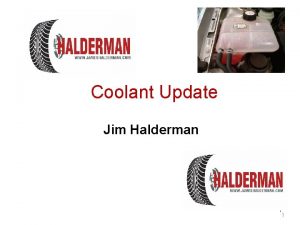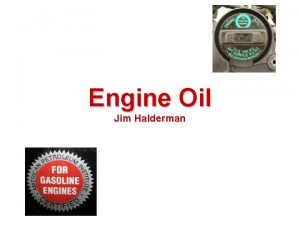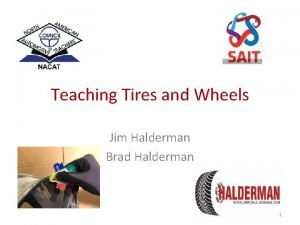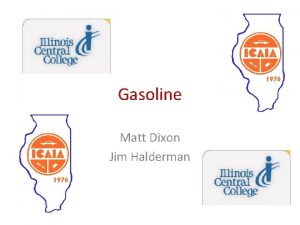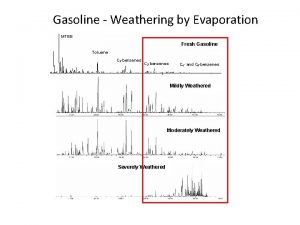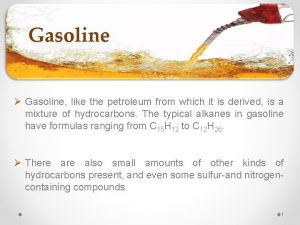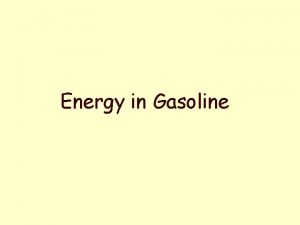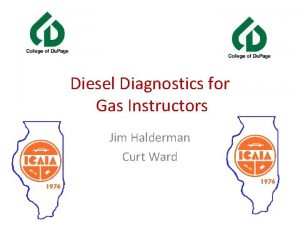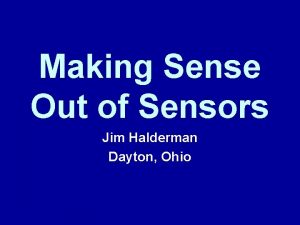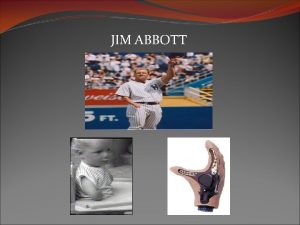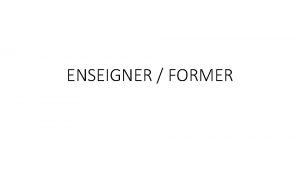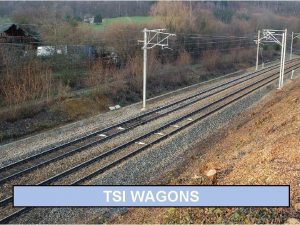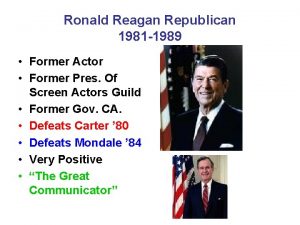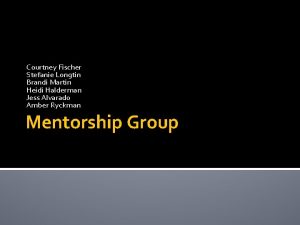Gasoline Update Jim Halderman Introduction Jim Halderman Former






























































- Slides: 62

Gasoline Update Jim Halderman

Introduction Jim Halderman • Former flat-rate technician, business owner and professor of Automotive Technology; author

Topics to be Discussed • • • What is gasoline? Octane ratings and what they mean Oxygenated and reformulated gasoline Reid vapor pressure/seasonal changes Alcohol content (E 10; E 15; E 85) Testing gasoline for contamination Recommendations/suggestions Gasoline taxes Tier 3 Emission standards-2017

What is Gasoline? Gasoline is a hydrocarbon fuel made from hydrocarbons with 1 to 15 carbon atoms. • • • Methane = one carbon Ethane = two carbons Propane = three Butane = four Pentane = five Hexane = six Heptane = seven Octane = eight Nonane= nine Decane= ten

Distillation

Transportation of gasoline • All gasoline that meets grade is called fungible. • This means that regardless of what company refines the gasoline, it can be mixed without a problem because it is all the same.

Energy Content of gasoline • BTU content varies with seasonal RVP blends and amount of alcohol • 108, 000 to 117, 000 BTU’s (generally higher during summer months) • For comparison, ethanol has about 76, 000 BTU

Additives Since 1995 EPA has required a. LL gasolines sold to have detergents blended in Other additives: • Anti-Icing • Anti Oxidants • Metal Deactivators • Corrosion inhibitors • Oil soluble dye • Gasoline sold for off-road use in Canada is dyed purple.

Worldwide Fuel Charter • Document containing of gasoline specifications by Alliance of Automobile Manufacturers • Top Tier Gasoline is gasoline that has engine cleaning chemicals to help reduce engine deposits. • www. toptiergas. com

TOP TIER Stations • • • • 76 Stations Aloha Petroleum ARCO Beacon BP Chevron Conoco Costco Wholesale Country Mark Diamond Shamrock Entec Stations Express Convenience Centers Exxon Hawaii Fueling Network (HFN) • • • • Holiday Station stores Kwik Trip / Kwik Star MFA Oil Co. Mobil Ohana Fuels Phillips 66 Quik. Trip Road Ranger Shamrock Shell Sinclair Suncor Energy Inc Super America Texaco Tri-Par Oil Co. Valero

Alcohol: Ethanol The current oxygenate of choice, gasoline reaches 3. 1% oxygen by weight with a 6. 2% ethanol volume Boosts octane rating (ethanol is 108 octane) Lowers energy content Impact on RVP

Gasoline/Alcohol Blending • Done at the distributor level • Usually locally • Designed to meet local conditions and climatic

Inline Blending • Gasoline and ethanol are mixed in a storage tank or in the tank of a transport truck while it is being filled. Because the quantities of each can be accurately measured, this method is most likely to produce a well mixed blend of ethanol and gasoline

Sequential Blending This method is usually performed at the wholesale terminal and involves adding a measured amount of ethanol to a tank truck followed by a measured amount of gasoline.

Splash Blending Done at the retail outlet or distributor and involves separate purchases of ethanol and gasoline. • A distributor can purchase gasoline, and then drive to another supplier and purchase ethanol. • The ethanol is then added (splashed) into the tank of gasoline. This method is the leastaccurate method of blending and can result in ethanol for E 10 that should be 10% to range from 5% to over 20% in some cases

EPA on E 15 EPA final rule allows E 15 and requires pump labeling

Octane Ratings Octane rating is the measured ratio between: • Iso-octane = 100 octane • Heptane = zero octane

Pump Octane Number • The rating on the pumps is the average of two ratings: Motor (MON) and Research (RON) • R+M/2 • Regular = 87 • Midgrade (plus) = 89 • Premium = 91+

Two Octane Methods Research Method (RON)– Uses no spark advance Results in higher number of the two Motor Method (MON)Uses spark advance Results in a lower rating number

Midgrade Recommended Refer to Service Info or Owner’s Manual

Station in N. M. @ 5, 000 ft. High altitude octane Air less dense Less pressure and heat Lowers engine octane needs • Some vehicle manufacturers still recommend 87 regardless of altitude • •

Tetraethyl lead (TEL) (CH₃CH₂)₄ Pb • Anti-knock agent of the past • Coats catalysts and oxygen sensor surfaces rendering them ineffective and hence the ban • Clean Air Act (CCA) of 1990 prohibited sale of gasoline containing lead after 1995 for on road use

After Lead… Refiners in the 1980 s needed away to boost octane 1. Increased aromatics % (some toxic) 2. Increased butane content (led to high vapor) 3. Used alcohol ethers such as MTBE, ETBE and TAME When oxygenated and reformulated fuel requirements came along in the 1990 s MTBE was the most popular oxygenate

MTBE (methyl tertiary butyl ether) • MTBE, an alcohol ether, most widely used oxygenate of 1990 s reformulated gasoline • Because of groundwater contamination issues, 25 states banned or severely limited MTBE between 1999 -2009

MTBE Ban

ETBE • Ethyl Tertiary Butyl Ether • Another oxygenate and octane enhancer • More expensive than MTBE • If gasoline is blended with ETBE at 20% volume the oxygen weight is about 3. 2% • Still currently used in small quantities in some areas

TAME • Tert- Amyl methyl ether • Smells like ether • Oxygenate and octane booster for gasoline • Needed about 20% blend by volume to exceed 3. 1% oxygenate by weight • Still currently used in some areas

MMT • Methylcyclopentadienyl manganese tricarbonyl is an organomanganese compound with the formula Mn(CO)₃. • Marketed as a gasoline additive to increase a fuel's octane rating. • Banned by the EPA in the US.

MMT warning from Jeep owners manual

MMT leaves rust-like appearance When octane booster is used, the spark plugs look “rusty” leading some technicians to think that there is a coolant leak into the combustion chamber.

Oxygenated Gasoline: Winter Months Required in CO non attainment zones. Two levels: • Base is 2. 7% oxygen by weight • Continued offenders: 3. 1% by weight Ethanol= The current oxygenate of choice In the past: MTBE, ETBE and TAME

Reformulated Gasoline (RFG) 1995 -current -“Ozone nonattainment zones” Requires: • lower volatility • lower benzene % • limits on other volatile organic compounds • Limits on sulfur and no MMT • Originally required 2. 0% oxygen by weight

Volatility • Measure of how easily liquid gasoline vaporizes. • Most common method for technician is to measure RVP (Reid Vapor Pressure) • This is the pressure in PSI formed above the liquid sample when heated to 100°F Changes with seasons • Too numerically low= cold start issues • Too numerically high= excess purge, concern with EVAP leaks and possible vapor lock

EPA RVP requirements by county

RVP Testing

RVP test on E 85

Weight per gallon: Gasoline 6 lbs. ; Water about 8 lbs. Gasoline Water: heavier will sink to bottom

Diesel about 7. 25 lbs. ; E 85 about 6. 5 lbs. Both heavier than gasoline: sink to bottom Diesel E 85

Checking for Alcohol

Checking for Alcohol: E 85 • Filled to 50 ml with E 85 • Added 50 ml of water • Mark is at about 85 m. L which indicates about 70% alcohol

Gasoline vs. Alcohols Gasoline= Dielectric E 85 shows resistance

Kent-Moore J-44175 A fuel composition tester (SPX Kent-Moore J-44175) is the recommended tool, by General Motors, to use to test the alcohol content of gasoline.

Kent-Moore J-44175 This battery-powered tester uses light-emitting diodes (LEDs), meter lead terminals, and two small openings for the fuel sample.

Kent-Moore J-44175 The first step is to verify the operation of the tester by measuring the air frequency by selecting AC hertz on the meter. The air frequency should be between 35 Hz and 48 Hz.

Kent-Moore J-44175 After verifying that the tester is capable of correctly reading the air frequency, gasoline is poured into the testing cell of the tool.

Kent-Moore J-44175 Record the AC frequency as shown on the meter and subtract 50 from the reading (e. g. , 60. 50 − 50. 00 = 10. 5). This number (10. 5) is the percentage of alcohol in the gasoline sample.

Gas Pump Nozzle Sizes

Gas Pump Nozzle Sizes Gasoline Diesel 21 mm 24 mm

Gasoline use and storage recommendations • Most experts state that the shelf life of gasoline is 90 days. • Shelf life means that it works like new for 90 days but after that the light ends start to evaporate and oxidation starts to occur that affects its performance.

Gasoline use and storage recommendations = proper cans

Old oxidized gasoline results Honda Odyssey Lab Vehicle: Very Bad Smell!

Use a gasoline stabilizer to help avoid oxidation

Use fresh stabilizer in fresh gasoline Sta-Bil® states that their stabilizer : • Should be used within one year after being opened • Should be used within two years if not opened

Use precautions when filling the tank

Gasoline taxes Federal Excise Tax, currently: 18. 4 cents per gallon Each state also has excise and other taxes including sales tax Combined State and Federal taxes are about 57. 3 cents per gallon in Illinois (one of the higher taxed states)


Taxes/tax credits: Ethanol • Current Federal Law provides for a 51 cent/gallon credit for ethanol • This translates to 43. 3 cents for a gallon of E 85 or about 5. 1 cents for a gallon of E 10 • CAFE Flex fuel credits expire in 2020

Future regulations/ changes PM regulations (grams per mile) PM is a concern with GDI Reduction in sulfur? Sulfur measured in parts per million (PPM) or mg/KG • TIER 3 emissions requires suggests 10 PPM down from 30 PPM now • Sulfur measured by ASTM D 2622 -98 method • •

The Future?

Summary • Gasoline is a blend of many hydrocarbons • Weighs less than water, diesel, or ethanol • Store fuels in correctly colored and labeled containers • Use stabilizer if storing over 3 months

Summary • Fuel volatility varies with both time of year and location of purchase • Alcohol % varies with location of purchase and can be easily tested for percentage • Octane: R+M/2 anti knock rating, not all engines will benefit from higher ratings, refer to owner’s manual for correct grade • Price, regulation, and taxes are likely to increase

Contact Information • jim@jameshalderman. com • www. jimhalderman. com
 Backup and recovery techniques
Backup and recovery techniques James halderman crossword puzzle answers
James halderman crossword puzzle answers Halderman
Halderman 4e alignment
4e alignment Kelsey hayes abs module identification
Kelsey hayes abs module identification Stoichiometric gasoline
Stoichiometric gasoline Typically, high inflation is a sign of
Typically, high inflation is a sign of Pressure regulator
Pressure regulator What is a bulk-gaining product?
What is a bulk-gaining product? Barry lights his candles to get his hot air balloon to fly
Barry lights his candles to get his hot air balloon to fly Pictograms can be easily identified because they have a
Pictograms can be easily identified because they have a A company produces a gasoline additive
A company produces a gasoline additive Leaded gasoline history
Leaded gasoline history A 170 g sample of an unidentified compound contains
A 170 g sample of an unidentified compound contains Missy diwater
Missy diwater Mette pless motivationsorienteringer
Mette pless motivationsorienteringer My former speeches have but hit your thoughts
My former speeches have but hit your thoughts Hoe excavator dental instrument
Hoe excavator dental instrument Geometriska former i förskolan
Geometriska former i förskolan Elephant riding in phuket respuestas
Elephant riding in phuket respuestas Energy is defined as
Energy is defined as Cleoid discoid carver uses
Cleoid discoid carver uses Orphaned niece of parris
Orphaned niece of parris Kolets rena former
Kolets rena former Former xamarin cofounder icaza
Former xamarin cofounder icaza Ulike former for kommunikasjon
Ulike former for kommunikasjon Behold the former things have passed away
Behold the former things have passed away Vacuum forming basics
Vacuum forming basics Logos, patos og etos
Logos, patos og etos Thailand former name
Thailand former name Former knowledge
Former knowledge Thailand former name
Thailand former name Verb svenska
Verb svenska Timbres france neufs
Timbres france neufs Which sentence uses commas correctly the former astronaut
Which sentence uses commas correctly the former astronaut Former allies clash
Former allies clash Types of sprue in dentistry
Types of sprue in dentistry Former situation
Former situation Former le conditionnel
Former le conditionnel Den idealistiske ondskab forklaring
Den idealistiske ondskab forklaring Matematiske former
Matematiske former Alkoholmolekyl
Alkoholmolekyl Zechariah
Zechariah What are these
What are these University community plan update
University community plan update Temporary update problem in dbms
Temporary update problem in dbms Www. sab update. com
Www. sab update. com Lnes
Lnes Dokumen deskripsi sdmk
Dokumen deskripsi sdmk Gtcs prd examples
Gtcs prd examples Position update formula
Position update formula Position update formula
Position update formula Fiberhome hg6246r manual
Fiberhome hg6246r manual Move update compliance
Move update compliance Mdh situation update
Mdh situation update Iqcs help desk
Iqcs help desk Cucm native call queuing
Cucm native call queuing 811 locate request
811 locate request Gsm location update procedure
Gsm location update procedure Chrome update
Chrome update Dhl seafreight
Dhl seafreight Ddns-update-style none
Ddns-update-style none Food product knowledge
Food product knowledge

